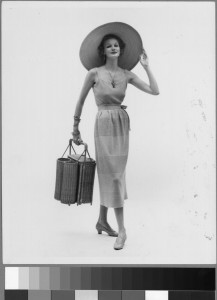The archive that I selected to take a closer look at was the Cashin (Bonnie) Collection of Fashion, Theater, and Film Costume Design, 1913-2000. I selected this archive because I think that fashion is an art form that is very reflective of what the society that the clothing was popular in valued the most.
The contents of the archive include two different types of items, images and manuscripts. The 21 manuscripts are all press clippings and advertisement of Cashin’s collection from 1937 to 1979. The almost 7,000 images include editorial or runway shots of Cashin’s collection throughout the whole time span. If I were to write a paper on this archive I could break it down and focus on several different topics.
I could just look at the press clippings and see what they have to say about the change in fashion advertising over the 20th century. What does it say about women and about how women should be presented? I could look at the drawn women figures and take out the clothing aspect, or I could just look at the layout, text, and design to see if that points to a change in advertising style.
I could also just look at the clothing itself. I could observe and possibly create some kind of dataset on different design elements and the year that they occurred in. For example, maybe I could estimate hemlines of skirts based off of all of the images and create a dataset on how those numbers changed throughout the years. Perhaps this dataset would somehow be visualized to suggest something having to do with the American woman and how she views modesty throughout the 20th century.
While this archive has a lot of information to base a potential project off of, it is lacking in any numbers or facts about the target demographic and sales of these products. With more information on the clients of Cashin, we could specify our conclusions to that specific group of people, and not generalize to the entire American female population. Also with sales information, and seeing if the clothing was very popular in certain decades over others could also prevent us from assuming that the clothes tell us something about society.
To remedy the lack of information on sales and the types of people purchasing the clothes, there should be more data. Also with client information, we could get locations of purchases and shipping addresses to possibly map where Cashin’s collection traveled.
